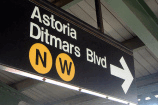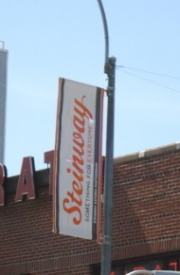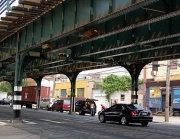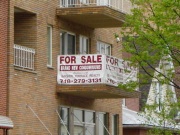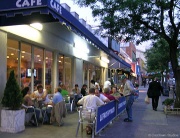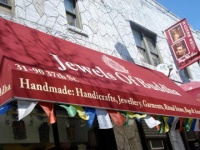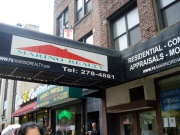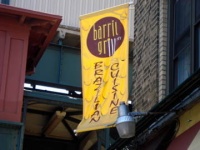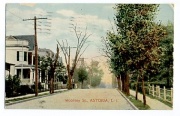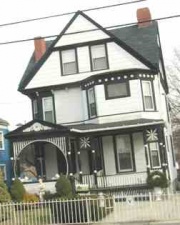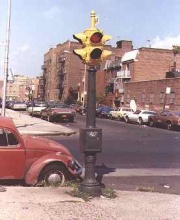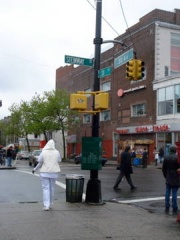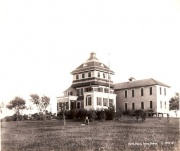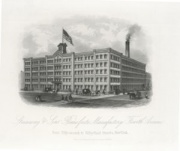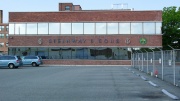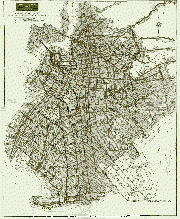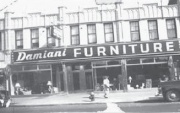| wiki | search |
Home
| Population Trends
| Gentrification
| Culinary Demography
| Architecture
Houses of Worship
| Art in Astoria
| Film Industry
| Steinway
| Index
| Contributors
Overview
The original settlers in Astoria were the Dutch and Germans, who arrived during the 17th century.[1]At the turn of the 19th century, the Czech, Irish, and Italians followed.[1]In the 1960’s and 70’s, waves of Greek immigrants came to America at the rate of 15,000 per year, settling mostly in Astoria.[2]However, the Greek influence in Astoria started declining over a decade ago. Unofficial estimates reduce Astoria’s Greek population from 45,000 to 30, 000 during the past two decades.[2]The 2000 census, however, states that the Greeks make up only 8.6% of the neighborhood’s population, a mere 18, 217 people.[2]The Greeks who established businesses and made their fortunes have moved upward in society, leaving Astoria for neighborhoods in Queens or Long island like Bayside, Little Neck and Whitestone.[3]The new immigrants replacing the Greeks who left are from diverse backgrounds, mostly Latin Americans, Middle Easterners, South and East Asians and Eastern Europeans.[4]On Steinway Street, the influence of North Africans, from countries such as Egypt or Morocco, and Middle Easterners, is easily spotted.[2]They have opened up hookah bars, halal restaurants and grocery stores and various other businesses relating to their culture. Brazilians, Ecuadorian, Colombians, Indians, Bangladeshis and the Chinese are also among the new immigrants moving into Astoria. [2]
Another change in Astoria’s population has occurred as people from Manhattan, Brooklyn and the Midwest move in.[1] They are attracted by the neighborhood’s cheaper rent, easy and quick access to Manhattan, safety, nightlife and diversity.[5]Young people from Manhattan are especially pouring in, but as they arrive, the cost of living in Astoria rises.[6]In 2001, Astoria suffered a housing shortage and the rents of apartments increased about 10-20%.[7]There has been more construction around Astoria, with new condos being built.
The Role of Gentrification
What is Gentrification?
A general definition of gentrification (or urban gentrification) is the movement of wealthier people into a particular urban area and the resulting dramatic change on the culture, demographics, median income and sometimes even racial makeup of these area.[8]Because there is a demand for houses in these urban areas by the more affluent people, the real estate value of these houses greatly increase resulting in higher rent and home prices. Due to the large increase in rent, many of the past renters are evicted. The demographics of these urban areas begin to change with a rise in median incomes, a decline in racial minorities and a reduction in household size, as low-income families are replaced by young singles and couples.[8] There is also an abundance of new luxury homes and condos being built throughout the area, making room for the richer incomers. Areas that have been already affected by gentrification include Park Slope, Brooklyn and Hoboken, New Jersey and Williamsburg Brooklyn. These areas are desirable due to their close proximity and easy access to New York City.
How has it affected Astoria?
Gentrification in Astoria began in the mid 1990’s, when “a wide variety of young professionals, artists, writers and musicians began to reside” in the neighborhood. Compared to Manhattan and parts of Brooklyn, the cost of living in Astoria is lower. The demographics of Astoria have changed as the relatively cheaper prices attract a variety of ethnic minorities in addition to the younger generations. Rather than consisting of mainly Greeks and Italians, the population has become more diversified to include South Americans, East and South Asians and Middle Easterners. Although the prices still remain cheaper than those of Manhattan, the influx of wealthier people has increased the prices of homes and apartments. In addition, mostly young couples and singles are moving in and they seek apartments rather than homes. Construction has been booming around Astoria to accommodate the demand for apartments and condos. Furthermore, residents have witnessed modernization of the neighborhood as cafes and Starbucks become established on many streets.[9]
Graphs
On average, the price per square foot of homes in Astoria has been higher compared to Queens overall. In the past, the number of sales in Astoria were somewhat higher than the general Queens area. Since 2006, homes sales in Astoria have been falling and now linger closer to the amount sold in Queens overall. Furthermore, the trend of Astoria’s median sales price usually opposes that of general Queens; it rises when the prices in Queens fall and lowers when the median sales prices in Queens increase. Since 2006, the price in Astoria has been higher than the median price in Queens overall.
The Faces of Astoria
Camera Shy Interviews
African-American employee of Theo and Theos
He notices that there are many Indians, East Asians, Greeks, and Hispanics living in Astoria. He sees condos and new buildings popping up. It’s peaceful in the neighborhood unlike Brooklyn and Manhattan. “Queens is the place to be!"
Mohammad from Iraq - Halal food vendor
Mohammad has been living in Astoria for 5 years and believes there are too many people moving in from Midtown where he previously worked. Currently, Astoria has more Greeks than Italians but there are also Egyptians and a lot more Eastern Europeans from countries like Albania, Yugoslavia and Bosnia. Because Astoria is very diverse, there is a lot of mixed food. The neighborhood’s been getting more expensive, almost like the city.
J. Jampa from Tibet - Owner of Jewels of Buddah
Jampa lived in Astoria for 10 years and moved to Woodside for a while. He disliked Woodside and moved back. He opened the store 5 months ago, which sells handcrafted jewelry, garments, bags, accessories and ritual items from Tibet and Nepal. There are a lot of Asians in Astoria but many Tibetans, Nepalis and Himalayans have joined the Indian people in Jackson Heights. There are also many Europeans in Astoria, like Russians, Greeks and Italians. The rent is cheaper in Astoria and it’s safer, nice and quiet. It is easy to catch the train here.
Lucia from Brazil - Employee of Barill Grill
Lucia has lived in Astoria for 20 years. 15 years ago, there used to be many Italians but they moved to other places like Bayside. There are a lot of Brazilians, Indians and Greeks living in Astoria now. Also, many hipsters and young people, especially students, are moving in from the city because it’s cheaper in Astoria but they raise the cost of living when they come.
Salvatore Marino - owner of Marino Realty
Marino has been working in Astoria for 40 years and notices that presently, the neighborhood is more open to younger people. It is not closed off with only a few European nationalities. There are currently many South Americans and Indians living in Astoria as well. Compared to Manhattan, the cost of living is lower so many people are moving in. Since October, the prices have been stable in Astoria. Also, many houses and buildings are ready to be occupied and quite a few are under construction. There has been a lot of modernization in the neighborhood, which is good because it is growing up. The changes are happening all over Astoria but especially on 30th Avenue, where there are many new cafes and restaurants.
Cristine Zikos of Zikos Realty
Zikos agrees with Salvatore Marino’s sentiments and calls Astoria “the next best thing to Manhattan.”
Sam of City Stop Realty
Sam concurs with the other realtors. He has been working in Astoria for nearly 8 years and notices that younger people from Manhattan are moving in. He estimates that there has been a 15%-20% increase in prices of homes and apartments.
Old Astoria vs. New Astoria
| Before | Now | Description |
|---|---|---|
| Woolsey Street, lined with trees, homes and white-picket fences in 1911, is present-day 14st Street. It is currently part of Old Astoria, an area known for its beautiful Victorian mansions and historic charm. The street hasn't really changed which shows that despite the modernization of Astoria and influx of new people, effort is being made to preserve the historical value of the neighborhood.[10] | ||
| Around the mid-1900s and present-day, 30th Avenue appears lined with apartment buildings and housing units. The designs of the cars and stoplights have changed and today, 30th Avenue is an important commercial area boasting many shopping stores and restaurants.[11] | ||
| In 1886, William Steinway built the 74th Sub-Precinct for the purposes of being a family resort. Instead, after opening 1899, it became a popular spot for gambling. In 1929, it was converted to an airfield, which is presently the location for LaGuardia Airport. LaGuardia is a portal through which new immigrants arrive in NYC. Astoria has become very diverse over the years, as the older established Greek and italian generations leave and more diverse newcomers replace them, hoping to make their own fortunes.[12] | ||
| In 1870, Steinway began buying property in Astoria to relocate the Steinway Factory from Manhattan. The image reflects the completed construction of the factory in 1876. The company has expanded globally but the original factory still exists on what is currently 1 Steinway Place. The company moved because Astoria was cheaper and they needed to cut costs to make their business thrive again. It is the same reason why people today are moving to Astoria.[13] | ||
| During the 1930s, trolleys were used as a mode of transportation is addition to trains and buses. The Steinway Street Station was built in 1933 and is still operating today. One reason Astoria attracts many new residents is its proximity to Manhattan, which is a quick subway ride away.[14] | ||
| Damiani Furniture, located on 32-37 Steinway Street, opened in 1937 and after 71 years of business, the owners retired and sold the store in 2008. It was bought by another furniture store whose business was located a few shops over at 32-65 Steinway Street. After buying Damiani Furniture, the owner, Steve sold his business- called Best Quality Furniture- and renamed the new enterprise Urban Lifestyle. This name is an attempt to attract the flood of young urban professionals that are presently moving into Astoria.[15] |
Footnotes
- ↑ 1.0 1.1 1.2 Berenstein, Erica. "Astoria — A Neighborhood In Constant Flux." Queens Chronicle. 12 June 2008. Queens Chronicle. 18 Apr. 2009 <http://www.zwire.com/site/news.cfm?newsid=19769154&BRD=2731&PAG=461&dept_id=580221&rfi=6>
- ↑ 2.0 2.1 2.2 2.3 2.4 Berger, Joseph. The World in a City. New York: Ballantine Books, 2007.
- ↑ Mbugua, Maria. "Greek Haven May Be Hurting: Is Astoria Nabe No Longer Mecca?" NY Daily News. 29 July 1999. NYDailyNews.com. 18 Apr. 2009 <http://www.nydailynews.com/archives/ny_local/1999/07/29/1999-07-29_greek_haven_may_be_hurting__.html>
- ↑ Jackson, Nancy Beth. "If You're Thinking of Living In/Astoria; Accessible, Affordable and Highly Diverse." The New York Times. 3 Oct. 2003. The New York Times Company. 18 Apr. 2009 <http://www.nytimes.com/2003/10/19/realestate/if-you-re-thinking-of-living-in-astoria-accessible-affordable-and-highly-diverse.html?scp=5&sq=astoria&st=cse&pagewanted=1>.
- ↑ Shepard, Richard F. "Astoria, a Greek Isle in the New York City Sea." The New York Times. 15 Nov. 1991. The New York Times Company. 18 Apr. 2009 <http://www.nytimes.com/1991/11/15/arts/astoria-a-greek-isle-in-the-new-york-city-sea.html?sec=travel&scp=3&sq=astoria&st=cse&pagewanted=1>.
- ↑ Sheridan, Dick. "Housing Crunch In Astoria." NY Daily News. 15 Nov. 1998. NYDailyNews.com. 18 Apr. 2009 <http://www.nydailynews.com/archives/ny_local/1998/11/15/1998-11-15_housing_crunch_in_astoria.html>.
- ↑ Herman, Eric. "Rents ease in Astoria Like Manhattan, high prices level off." NY Daily News. 21 May 2001. NYDailyNews.com. 18 Apr. 2009 <http://www.nydailynews.com/archives/money/2001/05/21/2001-05-21_rents_ease_in_astoria_like_m.html>.
- ↑ 8.0 8.1 http://www.pbs.org/pov/pov2003/flagwars/special_gentrification.html
- ↑ "The History of Astoria and Long Island City." MyAstoria.com. 2004. 4 May 2009 <http://www.myastoria.com/history/>
- ↑ Walsh, Kevin. "Street Necrology of Astoria." Forgotten-NY. 4 May 2009 <http://www.forgotten-ny.com/streetnecrology/astorianecro/astoria.html>.
- ↑ "Stopped Short: Classic NYC Stoplights." Forgotten-NY. 2001. 4 May 2009 <http://www.forgotten-ny.com/LAMPS/stopclassics/stopclassics.html>.
- ↑ "The Precincts of the Patrol Borough of Queens." Police N.Y. 4 May 2009 <http://www.policeny.com/thehousequeens1.html>.
- ↑ "Steinway & Sons Pianos." Steinway-Pianos.Net. 11 June 2008. Antiquarian Traders. 3 May 2009 <http://www.steinway-piano.net/herter_steinway.html>.
- ↑ "1930s B&QT Trolley Map." www.nycsubway.org. Www.nycsubway.org. 3 May 2009 <http://www.nycsubway.org/perl/caption.pl?/img/maps/bqt_trolley_1924.gif>
- ↑ "Damiani Says So Long to Steinway Street." 15 Aug. 2008. 3 May 2009 <http://queenscrap.blogspot.com/2008/08/damiani-says-so-long-to-steinway-street.html>.
Home
| Population Trends
| Gentrification
| Culinary Demography
| Architecture
Houses of Worship
| Art in Astoria
| Film Industry
| Steinway
| Index
| Contributors

